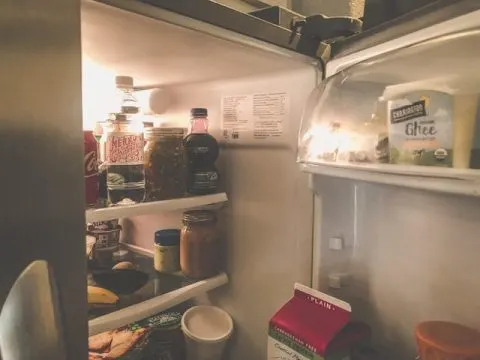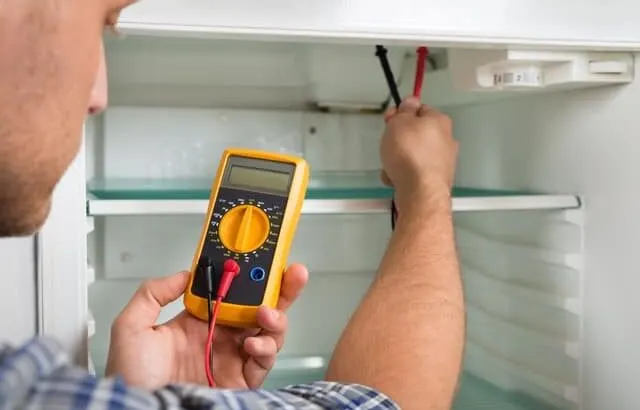Condensation in a refrigerator happens when moisture-laden, warm air cools. If this happens inside your refrigerator, you need to find the warm air source as soon as possible. In most cases, the warm air is coming in through the refrigerator door, but there’s the possibility that it’s coming from the food items that you’re storing inside your refrigerator.
Having a water pool at the bottom of your refrigerator doesn’t always mean that it’s caused by condensation. It can also happen because the refrigerator’s defrost mechanisms aren’t working properly.
Most refrigerators are built specially so they can deal with a bit of condensation through a drain at the bottom of your refrigerator’s cavity. But if you’ve started to notice water pooling or an excess of water, there are a few things that you can do to fix the condensation in your refrigerator.
How to Tell the Difference Between Condensation and Defroster Failure
Condensation in a refrigerator often collects on the surfaces inside your refrigerator, and when there’s enough condensation, it starts to drip. Because of this, you might notice other signs of condensation beyond just water pooling. Some of the other signs include corrosion of metal parts and mold.
If you’re having an issue with your refrigerator’s defroster, the water dripping will typically be location-specific, and the amount of water would be greater. You may even find water under the refrigerator on the floor when the defroster stops working. Condensation in a refrigerator seldom produces enough water for this to happen.
Condensation Sources
You might have noticed excess moisture inside your refrigerator on the sides of the unit, especially if you’re prone to putting hot items into your refrigerator. But the most common source of condensation in a refrigerator is outside air going through a worn refrigerator door gasket.
There are two simple tests that you can perform to verify if your gasket is worn out. The first test is to inspect the gasket for any blackening caused by mold, and the other one is called the dollar test. This second test involves closing the refrigerator door on a dollar between the gasket and the refrigerator.
If you can pull the dollar out with no resistance, the gasket isn’t creating a good seal.
Drainage Problems
There are a few things that you should look for if you’ve noticed water pooling in the bottom of your refrigerator.
Unblock the Drain
The very first thing that you should check is the drain hose. You should be able to find it at the back of your refrigerator near the bottom of the back wall.
Refrigerators are built in a way so that condensation can be filtered through the drainage hole into a small pan that sits on the top of the compressor. The water then evaporates because of the heat coming from the compressor.
Condensation in the refrigerator can become a problem when that drain is blocked. Try cleaning the drain with something like a cotton ball, or pipe cleaner, making sure to remove all blockages.
Look for a Build-Up of Ice
There are times when ice builds up on the back wall of the refrigerator. This is often caused by your refrigerator being too full, which prevents air from moving around. The moving air keeps the refrigerator frost-free.
If ice can build, this can prevent water from draining from the refrigerator. The best way to fix this problem is to de-ice the refrigerator by turning the unit off and allowing the ice to melt.
After the ice has melted, you should check the drain to ensure that it’s clear before turning the refrigerator on again.

Fixing Condensation in a Refrigerator
Every time the refrigerator door is opened, warm air will rush in and can create water droplets to form on the ceiling or back wall of your refrigerator.
Here are some things that you can do to prevent condensation in your refrigerator:
- Make sure that your refrigerator is clean outside and inside. Wipe the door seal down to make sure that the seal is making contact with the refrigerator correctly.
- Whenever you open the refrigerator, make sure to close the door as quickly as possible. Leaving the refrigerator door open for too long lets a lot of warm air into the unit and increases the possibility of condensation build-up.
- Ensure that your refrigerator temperature isn’t extremely cold or high. A good rule of thumb is setting your refrigerator temperature between 0- and 5-degrees F.
- Double-check that your refrigerator door properly closes and that the rubber gasket forms a complete seal. To give the seal a test, close the refrigerator door on a sheet of paper. If you can pull the paper out with no issues, the seal is loose and may need to be replaced.
- If your refrigerator isn’t level, the water won’t flow into the drain. Raise the floor front screws by a few turns to adjust the level of your refrigerator.
- Double-check that food is around room temperature or lower before you put it into your refrigerator.
Conclusion
There are several different reasons why you might notice condensation in the refrigerator. For one, the seal, or gasket, of your refrigerator could be worn out and not sealing properly. When there isn’t a tight seal in your refrigerator door, moisture-laden, warm air can enter your refrigerator and create a condensation problem.
Another problem could be that the drainage hole of your refrigerator is clogged. To fix this problem, you would need to use a cotton ball or pipe cleaner to eliminate any blockages that might be found on the drain.
Finally, you could have a build-up of ice inside your refrigerator, causing condensation in the refrigerator. To fix this problem, you need to unplug your refrigerator and let the ice melt completely and wipe down the surfaces inside the unit before plugging it back in.
Related Reading:
Refrigerator Keeps Tripping Breaker: Troubleshooting Guide
As a homeowner, I am constantly experimenting with making the structure of my house more energy-efficient, eliminating pests, and taking on DIY home improvement projects. Over the past two decades, my family has rehabbed houses and contracted new home builds and I’ve learned a lot along the way. I share my hard-learned lessons so that you can save time and money by not repeating my mistakes.


Leave a comment
You must be logged in to post a comment.